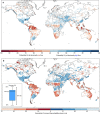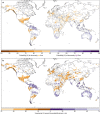Complex picture for likelihood of ENSO-driven flood hazard
- PMID: 28294113
- PMCID: PMC5355947
- DOI: 10.1038/ncomms14796
Complex picture for likelihood of ENSO-driven flood hazard
Abstract
El Niño and La Niña events, the extremes of ENSO climate variability, influence river flow and flooding at the global scale. Estimates of the historical probability of extreme (high or low) precipitation are used to provide vital information on the likelihood of adverse impacts during extreme ENSO events. However, the nonlinearity between precipitation and flood magnitude motivates the need for estimation of historical probabilities using analysis of hydrological data sets. Here, this analysis is undertaken using the ERA-20CM-R river flow reconstruction for the twentieth century. Our results show that the likelihood of increased or decreased flood hazard during ENSO events is much more complex than is often perceived and reported; probabilities vary greatly across the globe, with large uncertainties inherent in the data and clear differences when comparing the hydrological analysis to precipitation.
Conflict of interest statement
The authors declare no competing financial interests.
Figures





References
-
- McPhaden M. J., Zebiak S. E. & Glantz M. H. ENSO as an integrating concept in Earth science. Science 314, 1740–1745 (2006). - PubMed
-
- Chiew F. H. S. & McMahon T. A. Global ENSO-streamflow teleconnection, streamflow forecasting and interannual variability. Hydrolog. Sci. 47, 505–522 (2002).
-
- Ward P. J., Eisner S., Florke M., Dettinger M. D. & Kummu M. Annual flood sensitivities to El Nino-Southern Oscillation at the global scale. Hydrolog. Earth System Sci. 18, 47–66 (2014).
-
- Ward P. J., Kummu M. & Lall U. Flood frequencies and durations and their response to El Niño Southern Oscillation: global analysis. J. Hydrol. 539, 358–378 (2016).
Publication types
LinkOut - more resources
Full Text Sources
Other Literature Sources

